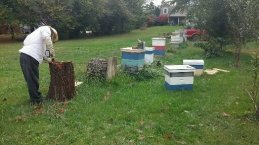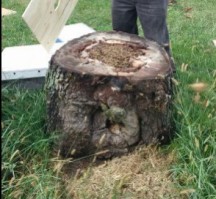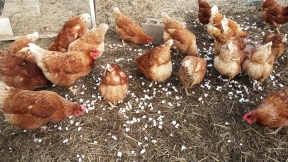Psalms from the Hive
by Jeannie Saum

Active heathy, hive box
Bees swarm
When we fail to brave the heat
To check on them
Chickens swoon to thieving raccoons
when doors don’t close in the dark
Cook and sell, travel and prosthelytize
Snare those bees, raccoons and possums
Wrangle some bees in the trees
All too soon, summer’s over.
Clover, Bee, and Revery
Reverie (revery) –(n.) state of dreamy meditation or fanciful musing; a fantastic, visionary, or impractical idea
BEEpothecary kept us so busy all spring and summer, that I haven’t written about our ventures and adventures in months. It was a juggling act to keep up with the growing business and still take care of our bees and chickens! With BEEpothecary, we did festivals and conferences in Delaware, Gahanna, Oxford,  Lithopolis, and Findlay, Ohio, and East Lansing and Frankenmuth, Michigan. We spent a whirlwind three days in the Bee Pavilion at the Ohio State Fair and participated in Gay Street’s Moonlig
Lithopolis, and Findlay, Ohio, and East Lansing and Frankenmuth, Michigan. We spent a whirlwind three days in the Bee Pavilion at the Ohio State Fair and participated in Gay Street’s Moonlig ht Market several times. We also added products to three new stores and have had a wonderful increase in online sales. It is exciting and gratifying when people write or come back to see us and say, “Your products do exactly what you said they would do!” More important to us than anything else is that people can benefit from the amazing things made by bees, and that these products might help someone when nothing else has worked.
ht Market several times. We also added products to three new stores and have had a wonderful increase in online sales. It is exciting and gratifying when people write or come back to see us and say, “Your products do exactly what you said they would do!” More important to us than anything else is that people can benefit from the amazing things made by bees, and that these products might help someone when nothing else has worked.
~ ~ ~ ~ ~
Since we lost all our hives but one, between our two apiaries, we needed to replace and rebuild this past spring. Keeping the bees is integral to our business and mission. We got 2 nucs in early spring for each family, that were bursting at the seams. We had to take a last trip out
our hives but one, between our two apiaries, we needed to replace and rebuild this past spring. Keeping the bees is integral to our business and mission. We got 2 nucs in early spring for each family, that were bursting at the seams. We had to take a last trip out to Kansas right at this time, for the final clean out of my mom’s home, so Laurie and Pete had to install our nucs into full-sized hives, as well as their own. Everything went fine until the last hive install at our house. This nuc was full to the brim and hot! Laurie got chased down the driveway, ripping her hat, veil and clothes off! She ended up with several stings!
to Kansas right at this time, for the final clean out of my mom’s home, so Laurie and Pete had to install our nucs into full-sized hives, as well as their own. Everything went fine until the last hive install at our house. This nuc was full to the brim and hot! Laurie got chased down the driveway, ripping her hat, veil and clothes off! She ended up with several stings!

~ ~ ~ ~ ~ 
We also ordered two bee packages and Ohio queens for both families. Pete and Laurie got some Russian bees to try another strain. When we picked them up, we found that the Ohio queens had not been available. Disappointing.
Pete and Laurie installed some of their bees in two top bar hives that took off well. Pete had built them with viewing windows and it was neat to watch the bees build and develop the hives. But in less than one week after putting in our package bees, one of the Dotson’s hives just absconded! They actually were outside and saw it happen. Then didn’t swarm, they just flew into the air, swirled around for a bit and then took off into the beyond. They were so disappointed. It’s hard to see over $100 in bees fly off into Neverland!
~ ~ ~ ~ ~ ~ ~
The rest of our hives grew quickly, though, and we had a great spring and early summer. And then the swarming started, en masse! I think we had about 3 swarms a week for about 3 weeks in a row, between the Saums, Dotsons and our friends down the street. Fortunately, the swarms landed nearby – mostly in our little trees out front, or in our son’s yard, next door to some beekeeping friends!

Steve and I were able to capture most of our swarms, since they landed in our little fruit trees. Pete and Laurie had a few swarms, too, so we’d trade the swarms we caught and put them into hive boxes in the other apiary. And for the swarms of our friends, that ended up in son, Nate’s, tall tree, so we had to call on him several times, to climb a ladder and capture a swarm! Young adult sons are very handy. We are so glad we let him live past 12 years old!!
Taking care of bees a hot sweaty job in the summer! We aren’t brave enough to handle the bees without our gear on. The extra layer – jacket, pants, helmet veil and gloves – makes quite a sweat box! You can’t wipe your brow, your glasses slip down your nose, and you can’t take a drink of water without taking off your hat and veil! We found we could only work on two or three hives at a time, and then take a break. I don’t know how these beekeepers with 200+ hive, do it!
~ ~ ~ ~ ~
~
Steve and Nate were even called upon twice, to come “wrangle” some bees in cut down trees. They brought home two big logs full of bees, by screwing boards over each end to cover up the holes, loading them into the truck with a farmer’s front loader, or by brute strength, and bringing them home. The ne xt step was to suck them out with a modified shop vac – a baffle to cut down on the suction so the bees didn’t end up – SPLAT! – on the inside of the shop vac. But then an experienced beekeeper suggested just putting a hive box with a few honey frames in it on top of each log. This would entice the bees and the queen to move up into the box and start laying there. Much easier! So that’s what we did. We’re overwintering them this way!
xt step was to suck them out with a modified shop vac – a baffle to cut down on the suction so the bees didn’t end up – SPLAT! – on the inside of the shop vac. But then an experienced beekeeper suggested just putting a hive box with a few honey frames in it on top of each log. This would entice the bees and the queen to move up into the box and start laying there. Much easier! So that’s what we did. We’re overwintering them this way!
Half way through the summer, one of the Dotson’s top bar colony’s just disappeared and shortly afterward, the other one was overcome by hive moths. This was a disappointing loss to an interesting project. It seems like we had swarms of swarms as the summer progressed! When people asked us how many hives we had, we couldn’t remember, the number had changed so many times! We got to harvest honey mid summer and then again in early fall. All in all, I think we ended up with over 400 pounds of honey!
And then there were the chicken adventures. Laurie wanted more chickens and got pullets to raise in a box in the garage, 2 different times, two different ages. . But once they got full-grown every time she tried to put the new ones in the coop with the old ones, all hell broke loose! They pecked one poor little  hen to death, and Laurie called the combining effort quits. This meant, she had to make a second coop for the younger birds, quick, since they had outgrown the box in the garage! She made a stationary one out of pallets, that was really quite nice, but lacked a door. In order to get eggs, or add water, she had to climb in and out of it each day! Eventually she decided to get rid of the older birds to a good home and put the younger ones in the movable coop!
hen to death, and Laurie called the combining effort quits. This meant, she had to make a second coop for the younger birds, quick, since they had outgrown the box in the garage! She made a stationary one out of pallets, that was really quite nice, but lacked a door. In order to get eggs, or add water, she had to climb in and out of it each day! Eventually she decided to get rid of the older birds to a good home and put the younger ones in the movable coop!
We, on the other hand, had a different kind of problem – predators. Since we had 25 birds, we really didn’t notice for a few weeks that our flock was shrinking. We saw no evidence of critters at first. But then, one day, we found a

They always expect a treat and love popcorn!
half-eaten chicken, in the coop, and realized that the automatic door was not closing at night and a critter was getting in. By the time we realized this, we had lost 8 birds! And of course this happened at a time we were scrambling to prepare product and running to shows. So I fixed the auto closer, while Steve got the live trap ready! It took only one night to snare a big, fat, well-fed raccoon! We read in the paper that week, that it was the season for all the young adult critters to leave their parents and head out on their own. Evidently raccoons and possums were becoming a problem in town, too. Interestingly, we read that it was against the law to relocate the critters! Guess you are not allowed to pass your problem on to someone else!! So, Steve dispatched that nasty, chicken-eating raccoon!
Since Pete and Laurie have a dog, they don’t have to worry much about critters getting to their chickens. Rowdy usually takes care of wild critters who wander into his territory, and often brings his snared prize to the back door steps as a gift! One day, he laid a big possum on the back steps and then lay inside at the door, in the cool air conditioning “guarding: his catch outside! And just before “Daddy” Pete came home, he moved his prize possum into Pete’s parking space in the driveway! A proud hunter! Thought sometimes, not too smart. More than once, Rowdy unwisely tangled with a skunk and had to have many tomato juice and peroxide baths for his error! Never did see a prized skunk body on the back steps at the Dotsons’!
Somehow, we made it through the summer of swarms, sales, sweat, snares, and bee wrangling – with 12 hives (I think), 23 chickens, a growing business and a dear friendship still intact! Praise God for his blessings and strength!
2 Samuel 22
31“As for God, his way is perfect: the e Lord’s word is flawless; he shields all who take refuge in him.
32 For who is God besides the Lord? And who is the Rock except our God?
33 It is God who arms me with strength and keeps my way secure.
34 He makes my feet like the feet of a deer; he causes me to stand on the heights.
35 He trains my hands for battle; my arms can bend a bow of bronze.
36 You make your saving help my shield; your help has made me great.
37 You provide a broad path for my feet, so that my ankles do not give way

 When a beeswax, olive oil and A. tinctoria (L.) Tausch mixture was applied to second degree burns, this accelerated epithelization, (growth of granulated tissue across a wound) reduced the pain experienced during dressing changes and shortened the hospital stay durations of the patients.
When a beeswax, olive oil and A. tinctoria (L.) Tausch mixture was applied to second degree burns, this accelerated epithelization, (growth of granulated tissue across a wound) reduced the pain experienced during dressing changes and shortened the hospital stay durations of the patients.










 mg/kg of propolis or 40 mg/kg of propolis, per day. The propolis fed groups showed a gradual decrease in the degeneration by fat deposits and a decrease in inflammation. It was concluded that the Chilean propolis decreased NAFLD , but that the mechanisms that caused this still must be identified.
mg/kg of propolis or 40 mg/kg of propolis, per day. The propolis fed groups showed a gradual decrease in the degeneration by fat deposits and a decrease in inflammation. It was concluded that the Chilean propolis decreased NAFLD , but that the mechanisms that caused this still must be identified.

 This powerhouse substance contains 500 times more bioflavonoids than is found in oranges. Flavonoids have strong antioxidant properties and help to protect cells from free radicals and cell mutations. Propolis contains all the known vitamins, except vitamin K. Propolis contains 13 of the 14 minerals our bodies reauire, with the exception of sulfur. You don’t have to swallow a whole handful of vitamins and minerals. Instead, you can use about 10 drops( about a half-dropperful) of 10% propolis oil or tincture, daily, to strengthen your immune system and supply your body with ample antioxidants, vitamins and minerals. And kill those nasty germs before they get established in your body!
This powerhouse substance contains 500 times more bioflavonoids than is found in oranges. Flavonoids have strong antioxidant properties and help to protect cells from free radicals and cell mutations. Propolis contains all the known vitamins, except vitamin K. Propolis contains 13 of the 14 minerals our bodies reauire, with the exception of sulfur. You don’t have to swallow a whole handful of vitamins and minerals. Instead, you can use about 10 drops( about a half-dropperful) of 10% propolis oil or tincture, daily, to strengthen your immune system and supply your body with ample antioxidants, vitamins and minerals. And kill those nasty germs before they get established in your body!












Recent Comments